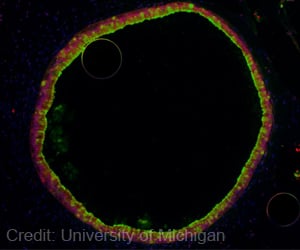Each human carries a unique collection of friendly intestinal microbes that aids in breaking down of food materials.

The research, by Jeffrey I. Gordon, MD, the Dr. Robert J. Glaser Distinguished University Professor and director of the Center for Genome Sciences & Systems Biology, and his team is reported online March 21 in the early online edition of the Proceedings of the National Academy of Sciences.
"This research helps set up a discovery pipeline in which we can deliberately manipulate collections of human intestinal microbes from people of different ages and cultures who are either healthy or sick," says Gordon, whose research first established a possible link between obesity and other facets of nutritional status and the mix of microbes that inhabit the intestine. "This gives us the opportunity to identify new groups of microbes that may be extremely beneficial in various therapeutic settings."
Researchers have grown bacterial microbes in the laboratory before, but until recently there's been no reliable way to know whether communities captured in a Petri dish mirror the extensive bacterial collections that exist in particular habitats of the body, such as the intestine.
"There are so many types of bacteria that live in different parts of our bodies, as well as substantial differences in these collections from person to person, that most scientists have thought we're probably missing a lot of the richness of microbial communities when we try to grow them in the laboratory," Gordon says. "But we found that the ability to successfully grow collections of gut microbes is much greater than had been expected."
For the study, the researchers obtained stool samples from two unrelated people. A portion of each sample was grown in the laboratory under strict "anaerobic" conditions because gut microbes live in an environment that lacks oxygen.
Advertisement
In all, they discovered that most of the different groups of intestinal bacteria found in an individual also were present in their corresponding bacterial collections that were grown, or cultured, in the laboratory.
Advertisement
The researchers then transplanted collections of microbial communities from the cultured and uncultured samples into the intestinal tracts of formerly germ-free mice. The mice, in essence, acquired a collection of gut microbes that mimicked the community in the original human donor.
By analyzing these "humanized" mice, the researchers demonstrated that both cultured and uncultured gut microbial communities from the same person behaved in the same manner when the mice were switched from their typical diet a low-fat, plant-based mouse chow to a standard western diet that is high in fat and sugar. Some species became more dominant and others less so, but the changes were virtually identical, regardless of whether the original sample was cultured or not.
The researchers also demonstrated they could split apart an entire community of cultured intestinal microbes and create a "personalized" library of bacterial species.
Microbes that react strongly to changes in diet or exposure to antibiotics, for example, can be retrieved from these libraries and their genomes can be sequenced to help understand why they respond as they do. Then, these microbes can be reunited with other members of a microbial community in germ-free mice to create more simplified models of human gut communities.
Gordon envisions that this approach makes it possible to obtain personalized microbial communities from people around the world who consume different diets and from individuals who are obese or malnourished or who have Crohn's or other diseases.
"This gives us the ability to test the contributions of specific microbes or groups of microbes and their influence on a person's health," Gordon explains. "One central question we hope to answer is how much of a person's overall nutritional status can be ascribed to their gut microbes and whether nutritional status can be improved by therapeutic interventions directed to gut microbial communities."
Source-Eurekalert








